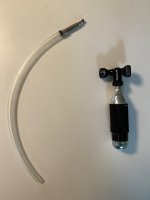OK so a few months ago I wrote in this forum about the potential effect of purging the headspace of a NEIPA with CO2 in order to prolong the shelf life of the beer. And while I enjoyed reading all the replies it all got a bit speculative and I didn't feel I had anything to add by prolonging the discussion. So I never replied...
Instead I decided to do some science!
AIM:
To investigate the effect of headspace size and CO2 purging in the bottling process.
METHOD:
I brewed a 5% NEIPA with 50% Pale Ale, 20 % Munich, 10% Wheat, 10% Oats, 10 % DME. Everything went into the primary with some Opshaug from a farm in Norway (Norwegian farmhouse kveik brewers yeast online store | Kveikshop). Dry hopped for 5 days and cold crashed with a CO2 filled bag covering the airlock.
I bottled directly from the primary after a couple of weeks in total with a bottle wand. I used sugar cubes as my priming sugar in every bottle.
The bottles were filled in three different ways.
1. Filled with the bottle wand leaving a normal headspace when removed
2. Filled with the bottle wand, then continued filling with bottle wand removed until about 10mm from the bottom of the cap
3. Filled to around 10mm from the bottom of the cap and purged with CO2.

Different bottling methods
The purging method involved using small CO2 cartridges and a CO2-valve used for bike tires with a small tube attached. I blew some CO2 into the liquid (trying to create bubbles) and capped within a few seconds.
I drank most of the beer but left 3 bottles in a fridge att 2 C for about 4 months

The final product!
RESULTS:
Colour: The differences in colour between the headspace beer and the beers without headspace was obvious. The difference between the purged and non-purged variants was more subtle. All 3 people in the testing panel chose the CO2-purged beer as the brightest

CO2 purged beer vs headspace beer after 4 months

Headspace vs CO2 purge vs No headspace (no CO2)
Aroma: Blind testing was pretty inconclusive here. Each beer had som hop character left but the difference wasn't too dramatic. Maybe we just suck at smelling?
Taste: The panel agreed that the beers without headspace had much more fruity, juicy notes. The beer with headspace was even described as being more bitter than the others.
CONCLUSION:
Minimising headspace and purging with CO2 is an effective way of prolonging the life of NEIPA. In the absence of CO2, minimising headspace works on its own, though to a lesser degree.

Instead I decided to do some science!
AIM:
To investigate the effect of headspace size and CO2 purging in the bottling process.
METHOD:
I brewed a 5% NEIPA with 50% Pale Ale, 20 % Munich, 10% Wheat, 10% Oats, 10 % DME. Everything went into the primary with some Opshaug from a farm in Norway (Norwegian farmhouse kveik brewers yeast online store | Kveikshop). Dry hopped for 5 days and cold crashed with a CO2 filled bag covering the airlock.
I bottled directly from the primary after a couple of weeks in total with a bottle wand. I used sugar cubes as my priming sugar in every bottle.
The bottles were filled in three different ways.
1. Filled with the bottle wand leaving a normal headspace when removed
2. Filled with the bottle wand, then continued filling with bottle wand removed until about 10mm from the bottom of the cap
3. Filled to around 10mm from the bottom of the cap and purged with CO2.

Different bottling methods
The purging method involved using small CO2 cartridges and a CO2-valve used for bike tires with a small tube attached. I blew some CO2 into the liquid (trying to create bubbles) and capped within a few seconds.
I drank most of the beer but left 3 bottles in a fridge att 2 C for about 4 months

The final product!
RESULTS:
Colour: The differences in colour between the headspace beer and the beers without headspace was obvious. The difference between the purged and non-purged variants was more subtle. All 3 people in the testing panel chose the CO2-purged beer as the brightest

CO2 purged beer vs headspace beer after 4 months

Headspace vs CO2 purge vs No headspace (no CO2)
Aroma: Blind testing was pretty inconclusive here. Each beer had som hop character left but the difference wasn't too dramatic. Maybe we just suck at smelling?
Taste: The panel agreed that the beers without headspace had much more fruity, juicy notes. The beer with headspace was even described as being more bitter than the others.
CONCLUSION:
Minimising headspace and purging with CO2 is an effective way of prolonging the life of NEIPA. In the absence of CO2, minimising headspace works on its own, though to a lesser degree.
















































![Craft A Brew - Safale S-04 Dry Yeast - Fermentis - English Ale Dry Yeast - For English and American Ales and Hard Apple Ciders - Ingredients for Home Brewing - Beer Making Supplies - [1 Pack]](https://m.media-amazon.com/images/I/41fVGNh6JfL._SL500_.jpg)











